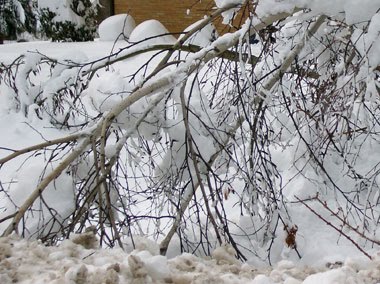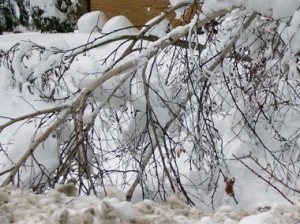
16 Feb Wait Until Spring To Assess Winter’s Damage To Your Trees & Shrubs Removing Snow Can Often Result In Additional Damage
 Removing Snow Can Often Result In Additional Damage
Removing Snow Can Often Result In Additional Damage
With this winter’s snowfall here in New Jersey on record pace, many homeowners and businesses are left to wonder — and hope — if whether or not their beautiful trees and shrubs will be able to survive yet another round of Mother Nature’s cruelest season.
But in most succinct of terms, here’s your answer . . . have patience.
“We tell our customers to let the season run its course, then assess the situation in early spring,” said Ralph Dinizo, President of Truesdale Landscape Services & Nursery of Berkeley Heights, N.J. “Trees and shrubs can be very resilient, and while they may not look to be in great shape covered in snow and ice, then can rebound quite nicely with the change of the season.”
Dinizo suggests waiting until the first half of March to begin an initial assessment of winter’s impact.
For example, while snow damage can appear to be worse on evergreens because the foliage holds the snow on the branches, these are strong trees that will usually bounce back after the snow melts and they regain most or all of their original shape.
And on shrubs like like Boxwoods, Yews and Azaleas, the outer branches can become weighed down with snow, separated from the center and pinned to the ground. Likewise, removing the snow can often result in more damage to the shrub, so again, the best practice is to allow the snow to melt off naturally.
“Take your time when doing inventory of your trees and shrubs in the early spring, as every species handles the elements differently,” stressed Dinizo.
Some other handy tips:
• If branches don’t bounce back into place after the snow melts off, they can be tied back into place with sisal twine. In this case, it’s best to tie the shrub in three places (bottom, middle and top), but not too tightly, and leave it this way for about a year. This works well on shrubs, but if it’s a hedge, it’s best to rather drive metal fence posts along the hedge every 8-10 inches, then stretch two or three levels of wire between them (depending on the height of the hedge) to pull the branches back up and hold them in place.
• If a smaller tree branch has split or cracked slightly and the damage is not too severe, it can actually be held together with first-aid tape or plastic electrical tape to hold it together. The layers will knit together over time, and the wound will eventually heal.
• Broken branches and those severely damaged or split should be cut off completely. And remember, additional pruning to re-shape the tree may be necessary.
• Some evergreens, such as Pines, Firs, Spruces, Arborvitaes and Junipers, cannot be cut back hard because there are few or no dormant buds in their barks. But the good news is these will likely jump back into place once all snow melts, so again, wait until the early spring to make these determinations.
• On the other hand, such shrubs as Azaleas, Rhododendrons, Hollys, Yews and Boxwoods enjoy dormant buds in their barks, and will produce new growth when pruned in early spring (while these buds are still dormant).
• And always remember to fertilize shrubs after severe pruning.
“With the proper TLC, the vast majority of your trees and shrubs can be restored after a particularly harsh winter like the one we’re in the midst of,” concluded Dinizo. “Don’t rush to judgment. The old saying ‘patience is a virtue’ can save much of the beautiful landscaping you’ve worked so hard to build, grow and enjoy.“


